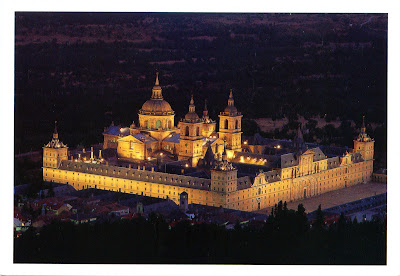May 2, 2013
0624 SPAIN (Community of Madrid) - Monastery and Site of the Escurial, Madrid (UNESCO WHS)
Originally a property of the Hieronymite monks, now a monastery of the Order of Saint Augustine, the Royal Seat of San Lorenzo de El Escorial is an historical residence of the King of Spain, located in the town with the same name, about 45km northwest of Madrid, at the foot of Mt. Abantos in the Sierra de Guadarrama. It comprises two architectural complexes of great historical and cultural significance: the royal monastery itself and La Granjilla de La Fresneda, a royal hunting lodge and monastic retreat.
The complex was erected by the Spanish architect Juan Bautista de Toledo, at the order of the King Philip II as a reaction to the Protestant Reformation from the 16th century, but also to emphasize the Spain's role as a center of the Christian world. In 1984 UNESCO declared Monastery and Site of the Escurial, Madrid a World Heritage Site. The traditional belief is that the design of the building, in the form of a gridiron, was chosen in honor of St. Lawrence, who was martyred by being roasted to death on a grill.
St. Lawrence's feast day is August 10, the same date as the Battle of St. Quentin (1557), in honor of which was erected El Escorial. The building is not only a convent and a royal palace, but also a pantheon, a basilica, a school, a library, the burial site for most of the Spanish kings of the last five centuries (Bourbons as well as Habsburgs), and an enormous storehouse of art. Built primarily from locally quarried gray granite, square and sparsely ornamented, El Escorial is austere, even forbidding, in its outward appearance, seemingly more like a fortress than a monastery or palace.
About the stamps
The first stamp on the right was issued on September 12, 2012 and depicts the old train station of Alcaudete, located in the municipality of Jaen, in the so called Oil Greenway. This train station no longer in use, and has been restored and turned into a hostel and leisure centre for walkers and cyclists who enjoy the old railway line now turned into a Vía Verde (Greenway), inaugurated in 2001.
The second stamp, showing a Class 242F steam locomotive and Castillo de La Mota, is part of a series of six, issued on September 29, 1958 and dedicated to XVII Congreso internacional de ferrocarriles, Madrid (17th International Railway Congress, Madrid):
• A Talgo train and Monastery of San Lorenzo de El Escorial (Madrid) - brown (15 c) - It's on other postcard 0699
• A diesel locomotive in Despenaperros (Jaen) (60 CTS)
• A steam locomotive class 242-F and Castillo de la Mota in Medina del Campo (Valladolid) - green (80 c) - It's on the postcard 0624
• A Talgo train and Monastery of San Lorenzo de El Escorial (Madrid) - orange (1 Ptas)
• A diesel locomotive in Despenaperros (Jaen) - purple (2 Ptas)
• A steam locomotive class 242-F and Castillo de la Mota in Medina del Campo - blue (Valladolid) (3 Ptas)
References
El Escorial - Wikipedia
Vías Verdes. Antigua Estación de Alcaudete - Correos Espana official website
Sender: Fabienne (direct swap)
Sent from Madrid (Community of Madrid / Spain), on 17.10.2012
Subscribe to:
Post Comments (Atom)




The Library and the Royal Pantheon are the most impressive rooms inside the Royal Palace.
ReplyDelete(My new blog http://postcardstampcollection.blogspot.com.es/ )
Hi Fabbiene. Glad I found you again. :) I owe you few postcards. Send me, please, an e-mail or a pm on facebook.
Delete